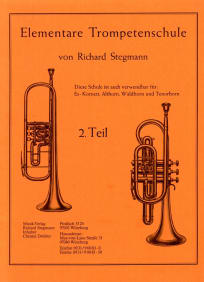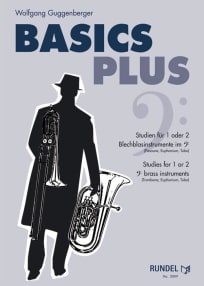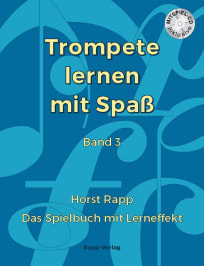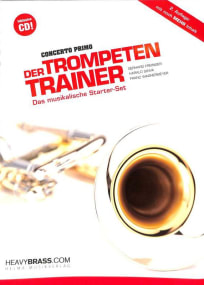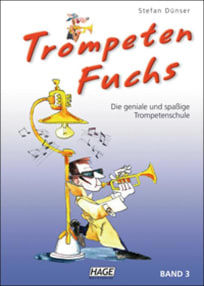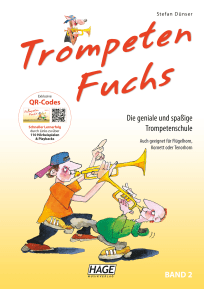Elementare Trompetenschule - Band 1 - RST01 | Music
HomepageMusicElementare Trompetenschule - Band 1 - RST01Methods
Elementare Trompetenschule - Band 1
auch verwendbar für: Es-Kornett, Althorn, Waldhorn und Tenorhorn
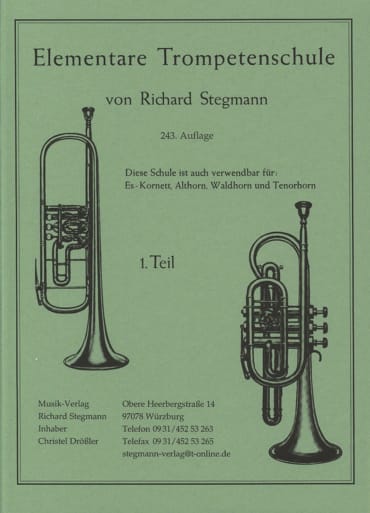
Methods
Elementare Trompetenschule - Band 1
auch verwendbar für: Es-Kornett, Althorn, Waldhorn und Tenorhorn
Editor
Genre
Grade Level
Unter-/Mittelstufe
Publisher
Stegmann
Size
A4
Order Number
RST01
Release Date
1955
Wishlist
Print
Share
Info
Preface:
With this elementary Book of Exercises for the Trumpet (Cornet á Piston) I hope to have composed a book of exercises which an every respect guarantees the normal, scientific and chronological education of the student. Above all I did my best to write such exercises as do not, at the beginning of the studies, overstrain the student as to the sound volume and range, the perseverance and the degree of difficulty of the exercises themselves, and as do not give him problems which he normally can solve only after one year of studies. This book was composed in a way (hat (he student can normally develop his tonguing, tact and punctuation as well as the technique of touch and the rhythm; the same is true of the short exercises, pieces, and songs. They were written and selected to match the character of the instrument so that they may form a solid basis for the later practical orchestra literature. curing my 30 years' activity as a teacher for trumpet at the Bayerische Staatskonservalorium der Musik (Bavarian State conservatory lor Music) in Wuerzburg, I had ample opportunity to get experiences in trumpet blowing which I pass on there, so that everybody interested my profit by it. If a man wants to become a trumpeter — as a professional musician or as an amateur — some indispensable natural conditions must be given. To find out, whether or not they are given, the person concerned, before starting his studies, should be examined by an expert. Most of the time the trumpet enthusiasts fail to do so and present themselves with instrument, mouthpiece and book of exercises to an expert, wanting TO BECOME A TRUMPETER.
Mostly these disciples of the art are not qualified for the Instrument and later are disappointed enough to have made all these expenses ior the teaching material in vain. You must be born a trumpeter, lor, as to the tonguing, the trumpet is the most difficult of all brass instruments. Here the saying comes true: Many are called, but few are selected. IS it were not so, there were many more excellent trumpeters' The first condition is that a good trumpeter has the right teeth structure. They should be regular in the upper and lower jaws and there must be no gaps between the teeth. If only one tooth has sharp edges or the wrong setting, because of the Song lasting pressure ot the mouthpipe against lips and teeth, the blower gels sore spots which may result in swollen lips, wounds and bubbles. The beauty of the sound, the mood. perseverance and the pilch are much influenced by that and the trumpeter is no longer enthusiastic at blowing, if he is still capable of blowing. He is alomost in the same situation as a hiker, who has a long march before him. and if. his shoe there is a little stone. Either he removes the stone, or he continues his way in spile of his hurting or sore foot, or he stops marching. The structure, that is the arrangement of the teeth on which the mouthpiece rests, consequently is of essential importance lor the artistic accomplishments of any trumpeter. Slight rough spots can be removed and polished by a good dentist, and these operations have proved excellent with many of my pupils. The second condition is suitable lips and cheek muscles! The lips should be narrow and thin! Thick lips with much red flesh are not suitable lor the trumpet blowing. They and the so-called trumpeter's muscles must by nature be well and strongly developed, these are the conditions lor easy high pitched sounds and great perseverance. II the trumpeter's muscles are weak and the lips soft and thick, it is advisable to choose another instrument, the tonguing of which is not so difficult as that of the trumpet. II this advice is not taken, the trumpeter remains a slave of his instrument all his life. Of course there might be objections to this statement: . But there are exceptions' one could say. True, and these exceptions prove the rule. Just as the cordal strings of a singer determine whether he should have a tenor or a bass voice, the lips of a blower are decisive for his qualification for the instrument. With thick tuba or trombone lips you cannot blow trumpet and with a bass voice you cannot sing the part ol a tenor.
A LESSON ON THE TONGUING OF THE MOUTHPIECE!
When I started my career as a trumpeter an expert informed me of the importance of the tonguing of the mouthpiece. So I became aware that the solution of this problem is decisive lor any brass blower — and especially lor the trumpeter. The excellent trumpeters with whom I was acquainted, put hall of the mouthpiece on the upper lip and hall on the lower lip. I have recognised this method as absolutely correct! I cannot enough warn against the method of tonguing, by which one third of the mouthpiece is put on the upper lip and two thirds on the lower lip. because then it is to be Seared that the trumpeter may put the inner edge of she mouthpiece in the red flesh of the upper lip, which makes trumpet blowing a hopeless adventure. Trumpeters who had been trained after Ibis wrong method were reoriented by my successfully; I made them put hat! for the bigger half) of the mouthpiece on the upper lip, as described above, and the rest on the lower lip. Further the students bad to hold sounds in the deepest registers only; this way I trained them about four weeks. Due to this method they forgot their former wrong tounguing. I made them blow the higher notes only gradually, which eliminated the risk of wrongly putting the mouthpiece again. My instruction to put hall (or the bigger hall) of the mouthpiece on the upper lip may be explained anatomically as follows: .The upper jaw is unmovabte and has greater and stronger teeth, consequently the stable and stronger part is made lor strength and perseverance. The lower jaw. on the contrary, is movable, the teeth are weaker and smaller, which suggests that this part should not be charged loo much: moreover the slighter tonguing of the tower lip is the essential condition lor the producing of! an effortless bridging of intervals of any kind and volume. The problem of the mouthpiece must be solved by every blower individually. Every blower must by and by find out, which mouthpiece suits him best. It never should be loo narrow or too flat, but must be adapted to the lips and teeth of the musicians. The inner opening of a trumpet mouthpiece should, if possible, have the diameter of a penny coin i. e. about 16 to 17 millimeters. For the German valve trumpet the conical muzzle is preferable. The globe muzzle is better suited lor (he jazz trumpet. The edge of! the mouthpiece should not be too narrow, nor too sharp nor too flat, but slightly curved. Breathing should not, or at least as little as possible be done through the nose. In this respect 1 am of the opinion, which was confirmed by doctors, that the best and quickest inhalation is done when the mouth is slightly opened.
With this elementary Book of Exercises for the Trumpet (Cornet á Piston) I hope to have composed a book of exercises which an every respect guarantees the normal, scientific and chronological education of the student. Above all I did my best to write such exercises as do not, at the beginning of the studies, overstrain the student as to the sound volume and range, the perseverance and the degree of difficulty of the exercises themselves, and as do not give him problems which he normally can solve only after one year of studies. This book was composed in a way (hat (he student can normally develop his tonguing, tact and punctuation as well as the technique of touch and the rhythm; the same is true of the short exercises, pieces, and songs. They were written and selected to match the character of the instrument so that they may form a solid basis for the later practical orchestra literature. curing my 30 years' activity as a teacher for trumpet at the Bayerische Staatskonservalorium der Musik (Bavarian State conservatory lor Music) in Wuerzburg, I had ample opportunity to get experiences in trumpet blowing which I pass on there, so that everybody interested my profit by it. If a man wants to become a trumpeter — as a professional musician or as an amateur — some indispensable natural conditions must be given. To find out, whether or not they are given, the person concerned, before starting his studies, should be examined by an expert. Most of the time the trumpet enthusiasts fail to do so and present themselves with instrument, mouthpiece and book of exercises to an expert, wanting TO BECOME A TRUMPETER.
Mostly these disciples of the art are not qualified for the Instrument and later are disappointed enough to have made all these expenses ior the teaching material in vain. You must be born a trumpeter, lor, as to the tonguing, the trumpet is the most difficult of all brass instruments. Here the saying comes true: Many are called, but few are selected. IS it were not so, there were many more excellent trumpeters' The first condition is that a good trumpeter has the right teeth structure. They should be regular in the upper and lower jaws and there must be no gaps between the teeth. If only one tooth has sharp edges or the wrong setting, because of the Song lasting pressure ot the mouthpipe against lips and teeth, the blower gels sore spots which may result in swollen lips, wounds and bubbles. The beauty of the sound, the mood. perseverance and the pilch are much influenced by that and the trumpeter is no longer enthusiastic at blowing, if he is still capable of blowing. He is alomost in the same situation as a hiker, who has a long march before him. and if. his shoe there is a little stone. Either he removes the stone, or he continues his way in spile of his hurting or sore foot, or he stops marching. The structure, that is the arrangement of the teeth on which the mouthpiece rests, consequently is of essential importance lor the artistic accomplishments of any trumpeter. Slight rough spots can be removed and polished by a good dentist, and these operations have proved excellent with many of my pupils. The second condition is suitable lips and cheek muscles! The lips should be narrow and thin! Thick lips with much red flesh are not suitable lor the trumpet blowing. They and the so-called trumpeter's muscles must by nature be well and strongly developed, these are the conditions lor easy high pitched sounds and great perseverance. II the trumpeter's muscles are weak and the lips soft and thick, it is advisable to choose another instrument, the tonguing of which is not so difficult as that of the trumpet. II this advice is not taken, the trumpeter remains a slave of his instrument all his life. Of course there might be objections to this statement: . But there are exceptions' one could say. True, and these exceptions prove the rule. Just as the cordal strings of a singer determine whether he should have a tenor or a bass voice, the lips of a blower are decisive for his qualification for the instrument. With thick tuba or trombone lips you cannot blow trumpet and with a bass voice you cannot sing the part ol a tenor.
A LESSON ON THE TONGUING OF THE MOUTHPIECE!
When I started my career as a trumpeter an expert informed me of the importance of the tonguing of the mouthpiece. So I became aware that the solution of this problem is decisive lor any brass blower — and especially lor the trumpeter. The excellent trumpeters with whom I was acquainted, put hall of the mouthpiece on the upper lip and hall on the lower lip. I have recognised this method as absolutely correct! I cannot enough warn against the method of tonguing, by which one third of the mouthpiece is put on the upper lip and two thirds on the lower lip. because then it is to be Seared that the trumpeter may put the inner edge of she mouthpiece in the red flesh of the upper lip, which makes trumpet blowing a hopeless adventure. Trumpeters who had been trained after Ibis wrong method were reoriented by my successfully; I made them put hat! for the bigger half) of the mouthpiece on the upper lip, as described above, and the rest on the lower lip. Further the students bad to hold sounds in the deepest registers only; this way I trained them about four weeks. Due to this method they forgot their former wrong tounguing. I made them blow the higher notes only gradually, which eliminated the risk of wrongly putting the mouthpiece again. My instruction to put hall (or the bigger hall) of the mouthpiece on the upper lip may be explained anatomically as follows: .The upper jaw is unmovabte and has greater and stronger teeth, consequently the stable and stronger part is made lor strength and perseverance. The lower jaw. on the contrary, is movable, the teeth are weaker and smaller, which suggests that this part should not be charged loo much: moreover the slighter tonguing of the tower lip is the essential condition lor the producing of! an effortless bridging of intervals of any kind and volume. The problem of the mouthpiece must be solved by every blower individually. Every blower must by and by find out, which mouthpiece suits him best. It never should be loo narrow or too flat, but must be adapted to the lips and teeth of the musicians. The inner opening of a trumpet mouthpiece should, if possible, have the diameter of a penny coin i. e. about 16 to 17 millimeters. For the German valve trumpet the conical muzzle is preferable. The globe muzzle is better suited lor (he jazz trumpet. The edge of! the mouthpiece should not be too narrow, nor too sharp nor too flat, but slightly curved. Breathing should not, or at least as little as possible be done through the nose. In this respect 1 am of the opinion, which was confirmed by doctors, that the best and quickest inhalation is done when the mouth is slightly opened.

